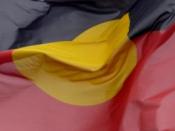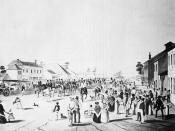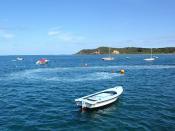Australian Aboriginal society has the longest continuous cultural history in the world. It is almost certain that the ancestors of today's Aborigines came across the sea from South-East Asia at least 50,000 years ago. Apart from a few carnivorous predators and poisonous snakes, the environment was relatively non-threatening to the continents first people. At the time of European settlement, SA is thought to have been populated by between 10,000 and 15,000 Aboriginal people living in 43 tribal groups.
Aboriginal people had an encyclopedic knowledge of the desert and its resources. Almost every facet of their lives was governed by millennia of ritual and tradition, with religious requirements a powerful influence. In fact, the overwhelming force in Aboriginal life was the obligation to observe laws handed down by spirit ancestors who had created the landscape and all life during the so-called Dreamtime. Aborigines also traded goods across Australia, using routes that followed the paths of Dreamtime ancestors.
Aboriginal people in SA suffered most from European settlement. They were stricken by disease and feared and even killed by farmers In 1966 the SA government made the first move of any state, to give Aboriginal people title to their land.
The first non-Aborigine to see SA's coast was the Dutch navigator Francois Thijssen aboard the Gulden Zeepaard, in 1627. He explored as far east as Nuyt's Archipelago. The French ships Recherche and L'Esperance, under Rear-Admiral Bruni d'Entrecasteaux, arrived in 1792, but they were confined to the west coast. The Admiral described the region as sterile and uniform. The first British explorer to arrive was Lieutenant James Grant, in 1800. He sailed along the far south-east coast and named several key features, including Mt Gambier and Mt Schank.
The English chose Royal Navy Lieutenant Matthew Flinders to beat the French in charting the Australian...



Well written
Very well written though (as already mentioned) references are needed. You fail to mention that South Australia was originally an Utilitarian experiment, which is why, in my opinion its history is more interesting then other state capitals.
2 out of 2 people found this comment useful.